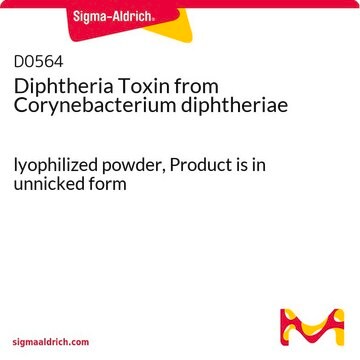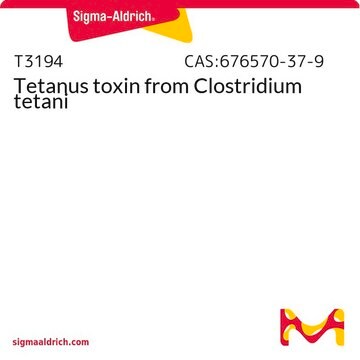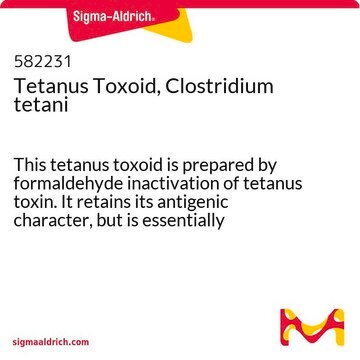Allgemeine Beschreibung
Diphtheria Toxin, Unnicked, from Corynebacterium diphtheriae catalyzes ADP-ribosylation of eukaryotic aminoacyltransferase II (EF2) using NAD as substrate, thereby inhibiting protein synthesis. May also induce inter-nucleosomal breakdown. Causes DNA fragmentation and cytolysis in U937 cells. Activation requires nicking with a protease followed by reduction with DTT. Diphtheria toxin, synthesized and excreted as a proenzyme, is composed of a single polypeptide chain of 63 kDa. For its enzymatic activity to be expressed, the toxin must undergo two covalent alterations in structure. First, a mild proteolysis results in the formation of an enzymatically inactive "nicked toxin," which consists of two major fragments (A and B) linked by a disulfide bond. Reduction of the nicked toxin with thiols (DTT) releases the enzymatically active N-terminal A fragment (24 kDa). The C-terminal B fragment (39 kDa) has no apparent enzymatic activity. The B fragment is required for toxicity and is responsible for recognizing and binding of the toxin to cell surface receptors.
Anwendung
Diphtheria Toxin, Unnicked, Corynebacterium diphtheriae has been used for intraperitoneal administration in mice for cell ablation.
Biochem./physiol. Wirkung
Das Produkt konkurriert nicht mit ATP.
Hinweis: Die Toxizität kann chargenabhängig variieren. Jedes Labor sollte die optimale Dosierung für jede einzelne Anwendung ermitteln.
Primärziel
Eukaryotische Aminoacyltransferase II (EF2)
Reversibel: nein
Zellpermeabel: nein
Warnhinweis
Toxizität: Gesundheitsschädlich (C)
Physikalische Form
Lyophilisiert aus sterilem 10 mM Tris, 1 mM EDTA, pH 7,5.
Rekonstituierung
Das chargenspezifische Rekonstituierungsvolumen entnehmen Sie bitte dem Fläschchenetikett.
Nach der Rekonstituierung in Aliquote aufteilen, rasch auf Trockeneis einfrieren und anschließend bei -70 °C einfrieren. Die Aliquote sollten ausschließlich bei Raumtemperatur wieder aufgetaut werden. Für Tests, in denen eine sehr geringe Konzentration des Diphtherietoxins zum Einsatz kommt, wird ein Trägerprotein wie BSA oder HSA empfohlen.
Hinweis zur Analyse
Hauptbande (unter reduzierenden Bedingungen) mit ~ 63 kDa
Sonstige Hinweise
Das Diphtherietoxin wird aus dem Corynebacterium-diphtheriae-Stamm Park Williams 8 durch ein modifiziertes Verfahren nach Pappenheimer et al. isoliert und aufgereinigt. Disk-Elektrophorese bei alkalischem pH-Wert unter nicht denaturierenden Bedingungen ergab, dass dieses Produkt als eine Hauptbande von 63 kDa wandert; dies entspricht dem intakten Toxin. Es können auch zwei schnellere, schwächer gefärbte Banden (24 und 39 kDa) auftreten, die den A- und B-Fragmenten entsprechen. Nach der Trypsinbehandlung in DTT zeigt das Diphtherietoxin in Tests auf seine Fähigkeit zur ADP-Ribosylierung der EF2 eine hohe Aktivität. Die ermittelte ED50 für CHO-Zellen beträgt ca. 0,4 ng/ml.
Diphtheria toxin is purified from Corynebacterium diphtheriae Park Williams strain 8 by a modified method of Pappenheimer, et al. As assessed by disc electrophoresis run at alkaline pH under non-denaturing conditions, this preparation migrates as a major band at 63 kDa, corresponding to the intact toxin. Two faster, more lightly stained bands (24 and 39 kDa), corresponding to A and B fragments, may be observed. Following trypsin treatment in DTT, diphtheria toxin exhibits high activity when assayed for its ability to ADP-ribosylate EF2. The ED50 for CHO cells is determined to be about 0.4 ng/ml.
Rechtliche Hinweise
CALBIOCHEM is a registered trademark of Merck KGaA, Darmstadt, Germany










